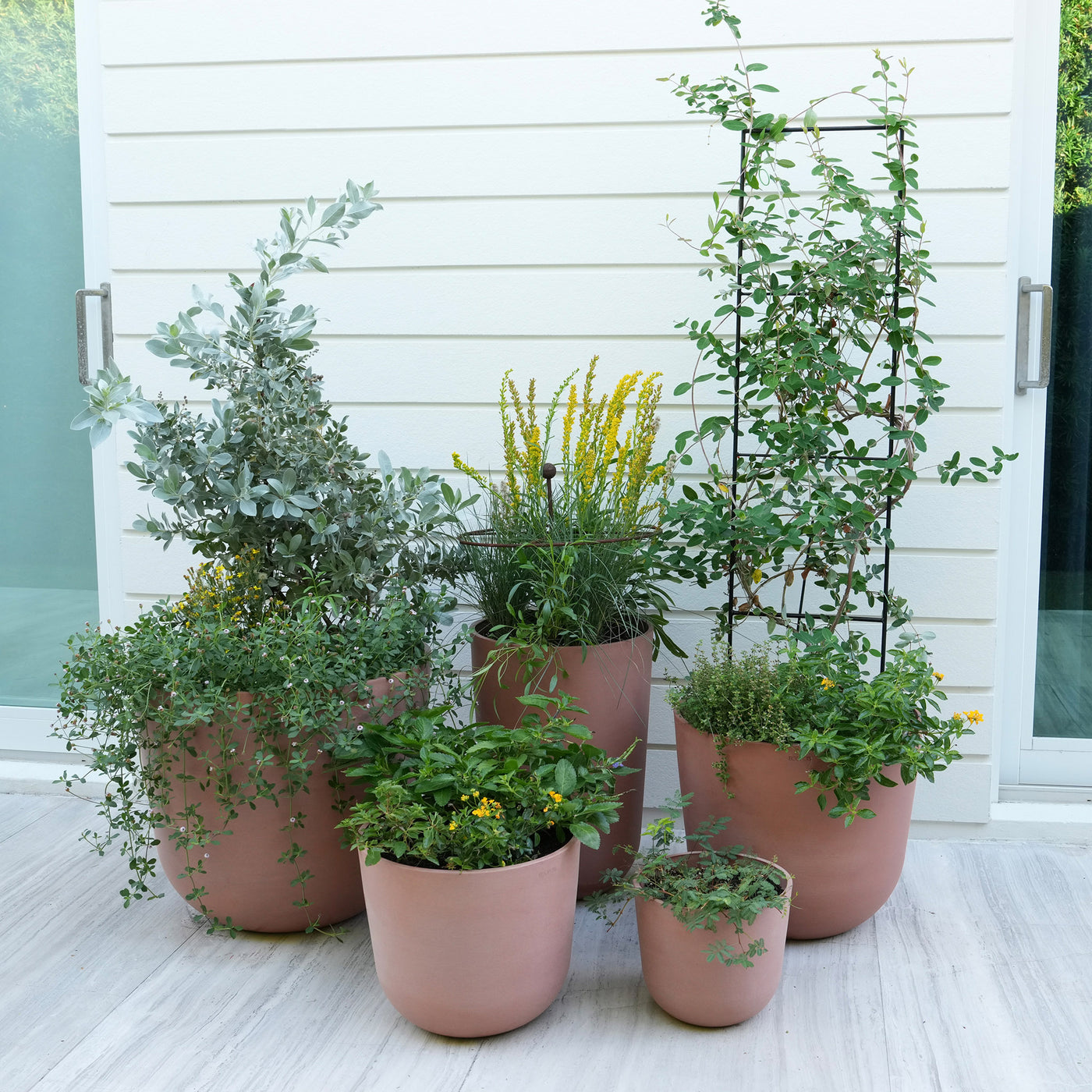Sunlit Symphony
This sun-soaked garden draws Ruby-throated Hummingbirds and Gulf Fritillaries, adding vibrant colors and life to sunny spaces.

How to water your native plants
Check the soil with your finger—if the top inch feels dry, it’s time to water!
1. In the morning, use room temp water
And avoid wetting leaves directly to help prevent disease.
2. In extreme heat, check moisture often
Check every 2-3 days. Plants go through more water when it’s hot.
3. Water deeply, and less frequently
A deep water ensures that lower roots get watered as well.
4. Use your 2 gallon watering can
Leave about 3.5 inches (4 fingers) unfilled to prevent spills.
| Planter size, Amount |
|---|
| X-Large Planter, 1 full watering can |
| Large & High Planter, ¾ watering can |
| Medium Planter, ½ watering can |
| Small Planter, ¼ watering can |
| Planter Size/Amount |
|---|
| X-Large Planter 1 full watering can |
| Large & High Planter ¾ watering can |
| Medium Planter ½ watering can |
| Small Planter ¼ watering can |
Sunlight Requirements
Your Sunlit Symphony Garden thrives in full sun (6+ hours of direct light daily).


To learn more about sunlight and potential issues, jump to Common issues & solutions down below.
Seasonal Growth & Pruning
Some native plants are naturally low-maintenance and don’t require pruning. The following plants benefit from seasonal trimming to maintain their health and shape.
| Plant | Pruning |
|---|---|
| Muhly Grass - Goldenrod | Trim in late winter before new growth appears. |
| Buttonwood | Lightly prune after flowering to shape. |
| Porterweed Blue - Pineland Lantana - Frogfruit | Pinch back stems occasionally to promote bushy growth. |
| Coral Honeysuckle | Trim as needed to control size and encourage flowering. |
| Mimosa - Havana Skullcap - Narrowleaf Silkgrass | Minimal pruning required; remove dead stems as needed. |
| Plant/Pruning |
|---|
| Muhly Grass - Goldenrod Trim in late winter before new growth appears. |
| Buttonwood Lightly prune after flowering to shape. |
| Porterweed Blue - Pineland Lantana - Frogfruit Pinch back stems occasionally to promote bushy growth. |
| Coral Honeysuckle Trim as needed to control size and encourage flowering. |
| Mimosa - Havana Skullcap - Narrowleaf Silkgrass Minimal pruning required; remove dead stems as needed. |
How to Prune Properly
Always wash your pruning tool with soap and water after each use to prevent the spread of plant diseases. If using kitchen scissors, make sure they are thoroughly cleaned before using them again for food preparation.
- Use sharp, clean gardening shears for the best results. A kitchen scissors can do the job for light trims, but a quality pair of garden shears will make pruning easier and more precise.
- Always cut just above a leaf node or where new growth is emerging to encourage healthy regrowth.
- Remove dead or damaged stems to improve airflow and plant health.
Common issues & solutions
| Issue | Cause | Solution |
|---|---|---|
| Wilting leaves | Lack of water | Water deeply and check soil moisture. |
| Soft yellow leaves | Overwatering | Reduce frequency and ensure proper drainage. |
| Dry yellow leaves | Lack of water or excess sun | Increase watering or move to a shadier spot. |
| Slow growth | Lack of light | Ensure a sunny location and regular pruning of dead stems. |
| Holes in leaves | Insects like caterpillars or leaf-eating insects | Identify before removing—beneficial caterpillars (Monarch Gulf Fritillary or Atala) should be left undisturbed. Harmful caterpillars & pests (armyworms or cutworms) can be removed by hand. For aphids & leaf-eating pests use a strong spray of water or apply neem oil. Spot-treat instead of spraying the entire plant; avoid flowers (as they are a nectar source); spray only in the evening to avoid harming butterflies and pollinators. |
| Few or no flowers | Lack of pruning or not enough direct sunlight | Light pruning and thinning to encourage better airflow. Move plants to a brighter sun location if they are not flowering. |
| Issue/Cause/Solutions |
|---|
| Wilting leaves Lack of water Water deeply and check soil moisture. |
| Soft yellow leaves Overwatering Reduce frequency and ensure proper drainage. |
| Dry yellow leaves Lack of water or excess sun Increase watering or move to a shadier spot. |
| Slow growth Lack of light Ensure a sunny location and regular pruning of dead stems. |
| Holes in leaves Insects like caterpillars or leaf-eating insects Identify before removing—beneficial caterpillars (Monarch Gulf Fritillary or Atala) should be left undisturbed. Harmful caterpillars & pests (armyworms or cutworms) can be removed by hand. For aphids & leaf-eating pests use a strong spray of water or apply neem oil. Spot-treat instead of spraying the entire plant; avoid flowers (as they are a nectar source); spray only in the evening to avoid harming butterflies and pollinators. |
| Few or no flowers Lack of pruning or not enough direct sunlight Light pruning and thinning to encourage better airflow. Move plants to a brighter sun location if they are not flowering. |
Contact us anytime! We’re here to support your journey.

